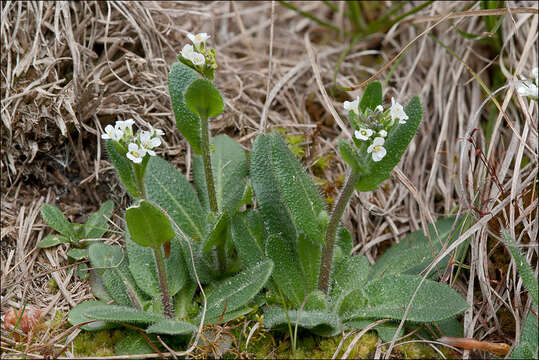Arabis-ciliata_4

Description:
Arabis ciliata var. hirta Clairv., syn.: Arabis corymbiflora VestFringed Rockcress, DE.: Doldige-Gnsekresse, Schirm-Gnsekresse, Wimper-GnsekresseSlo.: euljasti repnjakDat.: April 27. 2014Lat.: 46.36053 Long.: 13.70211Code: Bot_793/2014_DSC0630Habitat: stony deteriorated alpine pasture, modestly southeast inclined mountain slope, calcareous ground; open, dry place, full sun, exposed to direct rain, average precipitations ~ 3.000 mm/year, average temperature 7-9 deg C, elevation 610 m (2.000 feet), alpine phytogeographical region. Substratum: shallow soil, among low grasses and mosses, also on nearly bare ground.Place: Lower Trenta valley, between villages Soa and Trenta, 'Na melu' place, near Trenta 2b cottage, right bank of river Soa, East Julian Alps, Posoje, Slovenia EC Comment: Almost twenty species of the genus Arabis grow in Slovenia. Nearly all of them are quite similar with their small whitish to pale yellowish tiny flowers. They differ in habitus, hairs, shape and size of leafs and particularly fruit. To distinguish among species with certainty one usually needs to observe fruits too. The fact that the stalk and inflorescence grow vigorously during flowering period can confuse determination. Stalks of a plant in full seeds can be several times taller than when it starts to flower. Species Arabis ciliata comes in two flavors - subspecies. One is a hairless plants, the second one Arabis ciliata var. hirta has hairs, some of them are typically long and forked toward the top (see Fig.: 4b).Looking at our atlas of plant distribution (Ref.: (2)) it appears that Arabis ciliata is not at all a common species in Slovenia. There are only a few UTM squares where it was found and described. However, this small, inconspicuous plant is most probably overseen very frequently. It is probably much more common than botanical data show. The fact that it has been found in almost all UTM squares in the atlas of plant distribution of neighboring Alpine region of northeast Italy (Ref.:(3)) and that it grows everywhere in the Alps (Ref.:(5)) confirms this opinion. At the place where I photographed it, it grows abundantly. Pictures show young plants with still short stalks and inflorescence (with an exception of the picture of fruits).Ref.:(1) A. Martini et all., Mala Flora Slovenije, Tehnina Zaloba Slovenije (2007) (in Slovene), p 441. (2) N. Jogan (ed.), Gradivo za Atlas flore Slovenije (Materials for the Atlas of Flora of Slovenia), CKSF (2001), p 43(3) L. Poldini, Nuovo Atlante corologico delle piante vascolari nel Friuli Venezia Giulia,University of Trieste, Italy (2002), p 52.(4) M.A. Fischer, W. Adler, K. Oswald, Exkursionsflora sterreich Liechtenstein, Sdtirol, LO Landesmuseen, Linz, Austria (2005), p 630.(5) D. Aeschimann, K. Lauber, D.M. Moser, J.P. Theurillat, Flora Alpina, Vol. 1., Haupt (2004), p 530.
Included On The Following Pages:
This image is not featured in any collections.
Source Information
- license
- cc-by-nc-sa
- copyright
- Amadej Trnkoczy
- photographer
- Amadej Trnkoczy
- original
- original media file
- visit source
- partner site
- Flickr Group
- ID


